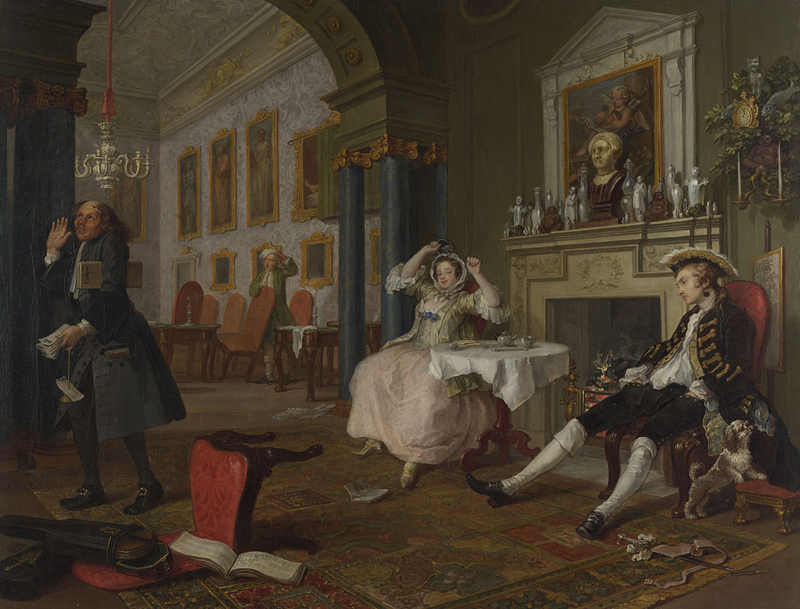9 December 2021
Hogarth and Europe
Tate Britain 3 November 2021 – 20 March 2022
Review by William Morton
This is an interesting Exhibition. Some of Hogarth’s works are very well-known such as the scene from the series, Marriage A-la-Mode, showing a very hung-over young husband slumped on a chair beside his restless and vapid wife and their steward clutching a fistful of unpaid bills. His influence on other artists has been considerable with the slightly grotesque and anarchic style of his satirical pictures being widely adopted. The Exhibition even includes two Chinese porcelain punch bowls decorated with reproductions of Hogarth’s painting, A Midnight Modern Conversation, (now lost).
The three satirical series, A Harlot’s Progress, A Rake’s Progress and Marriage A-la Mode have a common theme – initial innocence (or comparative innocence), followed by debauchery and ending in penury. They are sharp, without any redeeming features and full of sexual exploitation and drunkenness. The same edge is apparent in the painting, Southwark Fair. where a wooden stage for plays is shown collapsing amid all the general activity.
The Exhibition seeks to show Hogarth in the context of his European contemporaries and to some extent succeeds. Jeurat’s The Removal of the Effects of A Painter does have some similarity to Hogarth’s work in depicting poverty and city life. Cornelis Troost’s Misled: The Ambassador of the Rascals Exposes himself in which the ‘Ambassador’ is mooning from the upper storey of a pub definitely has a Hogarthian flavour. There is nothing glamorous about Crespi’s down to earth A Woman Looking for Fleas. Yet on the whole, these works lack the hard edge of Hogarth and his ability to see the skull beneath the skin. As perhaps a contrast, the Exhibition includes a fine Chardin, The Governess, depicting a gentler world.
Painting portraits was, of course, a major source of income for artists at the time and Hogarth produced some fine ones, many without any hint of satire. Having said that, his striking one of a well-known libertine, Sir Francis Dashwood at his Devotions, showing him gazing at a small figure of a naked woman, clearly contains a message and one which Dashwood was presumably happy with. Hogarth’s self-portrait and his picture of some of his servants are appealing.
The Tate helpfully provides visitors to each of its exhibitions with a booklet about it. The one for this Exhibition searches diligently for signs of racism, anti-Semitism and support for slavery in Hogarth’s work. It even says how many slaves William Beckford of Fonthill, who bought some Hogarths, owned, which does not seem relevant. What the booklet fails to do is give any information about Hogarth the man. It does not even give his dates (1697-1764).
He was the son of a schoolmaster, who was imprisoned for debt; he was apprenticed to an engraver and, although he did not complete his apprenticeship, he did work as an engraver. He also cut out the middleman by supervising the engraving of his own pictures. He did attend art classes in his youth. He was friendly with people such as Henry Fielding and Garrick and did marry. It would appear that he became quite wealthy and he was a founding Governor of the Foundling Hospital. In general, he would seem to have been an Establishment figure. That being so, why do his satirical works have such a hard edge? It is difficult to imagine that Hogarth could have produced them without having a deeply critical opinion of some of his fellow men and women and life at that time. It is a question not answered by the Exhibition.


